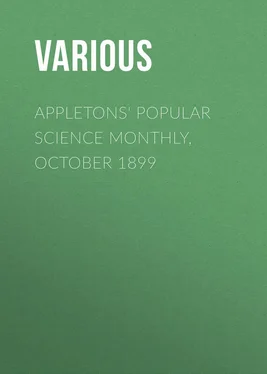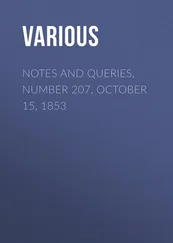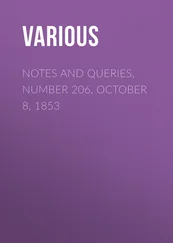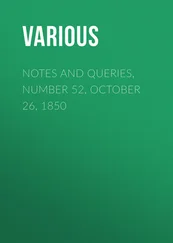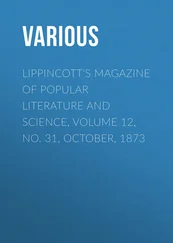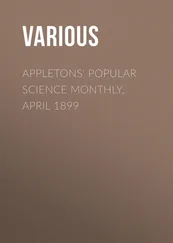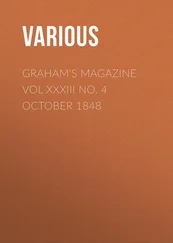Various - Appletons' Popular Science Monthly, October 1899
Здесь есть возможность читать онлайн «Various - Appletons' Popular Science Monthly, October 1899» — ознакомительный отрывок электронной книги совершенно бесплатно, а после прочтения отрывка купить полную версию. В некоторых случаях можно слушать аудио, скачать через торрент в формате fb2 и присутствует краткое содержание. Издательство: Иностранный паблик, Жанр: periodic, foreign_edu, на английском языке. Описание произведения, (предисловие) а так же отзывы посетителей доступны на портале библиотеки ЛибКат.
- Название:Appletons' Popular Science Monthly, October 1899
- Автор:
- Издательство:Иностранный паблик
- Жанр:
- Год:неизвестен
- ISBN:нет данных
- Рейтинг книги:3 / 5. Голосов: 1
-
Избранное:Добавить в избранное
- Отзывы:
-
Ваша оценка:
- 60
- 1
- 2
- 3
- 4
- 5
Appletons' Popular Science Monthly, October 1899: краткое содержание, описание и аннотация
Предлагаем к чтению аннотацию, описание, краткое содержание или предисловие (зависит от того, что написал сам автор книги «Appletons' Popular Science Monthly, October 1899»). Если вы не нашли необходимую информацию о книге — напишите в комментариях, мы постараемся отыскать её.
Appletons' Popular Science Monthly, October 1899 — читать онлайн ознакомительный отрывок
Ниже представлен текст книги, разбитый по страницам. Система сохранения места последней прочитанной страницы, позволяет с удобством читать онлайн бесплатно книгу «Appletons' Popular Science Monthly, October 1899», без необходимости каждый раз заново искать на чём Вы остановились. Поставьте закладку, и сможете в любой момент перейти на страницу, на которой закончили чтение.
Интервал:
Закладка:
Although the men do all the weaving, they do but little of it for themselves. For the greater part of the year their only garment is the loin cloth – a bit of store calico. In addition, they all own a shirt of cheap black or colored calico, which is generally more or less in rags, and a pair of loose, shapeless pantaloons, made often from some old flour sack or bit of white cotton sheeting. It is a rather incongruous sight to see some old Hopi, his thin legs incased in a dirty, ragged pair of flour-sack trousers, on which can still be traced "XXX Flour, Purest and Best."
Neither sex scarifies, tattoos, or paints any part of the body except in ceremonies, when colored paints are used as each ceremony requires. The men often wear large silver earrings, and suspend from their neck as many strands of shell and turquoise beads as their wealth will allow. Some of the younger men wear, in addition, a belt of large silver disks and a shirt and pantaloons of velvet. Most of their silver ornaments, it should be noted, however, have been secured in trade from the Navajos, who are the most expert silversmiths of the Southwest.
When the Hopi isn't spinning or weaving, he is in his kiva praying for rain, or he is in the field keeping the crows from his corn. I was once asked if the Hopis plow with oxen or horses. They use neither; they do not plow. When they plant corn they dig a deep hole in the earth with a long, sharp stick until they reach the moist soil. When the corn is sprouted and has reached a height of a few inches there is always the possibility of its being blown flat by the wind or overwhelmed in a sand storm. To provide against this the Hopi incloses the exposed parts of his little field with wind-breakers, made by planting in the earth thick rows of stout branches of brush. These hedges even are often overwhelmed by the sand and completely covered up.
And the crows, and the stray horses, and the cattle! Surely the poor Indian must fight very hard for his corn. For nearly two months he never leaves it unguarded, and that he may be comfortable he makes a shelter behind which he can escape the burning rays of the July and August sun. The shelters are occasionally rather pretentious affairs, at times consisting of a thick brush roof, supported by stout rafters which rest on upright posts. More often, however, they simply consist of a row of cottonwood poles, five or six feet high, set upright at a slight angle in the earth.
Although corn is by far the most important vegetable food, the rich though sun-parched soil yields large crops of beans and melons of all kinds.
Peach orchards also thrive in the sheltered valleys near the mesa, and in the fall great patches of peaches may be seen spread out to dry on the rocks of the mesa to the north of the village. Of both beans and peaches the Hopis generally have large quantities for the outside market, which they take over to the railroad on the backs of burros or ponies.
Before leaving the subject of the daily life of the male portion of Oraibi I have still to mention a curious weapon of which they make occasional use. This is the throwing-stick, or so-called boomerang, which differs only slightly from that used by the aborigines of Australia; the Hopi stick, however is better made, and is ornamented by short red and black lines. This is the weapon of the young men, and with it they work havoc with the rabbits which infest the valleys. But although they have good control over it, as can often be seen on their return from a hunt, they are not able to cause its return as can the Australians. At first thought it seems rather strange that the boomerang should have been evolved by two groups of mankind dwelling in parts of the world so remote, but we must look for the explanation of this phenomenon in the fact that the natural conditions of the two countries have much in common – a generally level, sandy country, with here and there patches of brush, a peculiar condition which would readily yield itself to the development of an equally peculiar and specialized weapon.
For fire the Hopi depends almost entirely on the rank growth of brush which is found along the ravines. This suffices to supply heat to the piki stone and the boiling pot, and enough to keep a fire on the hearth in the kiva. But now and then he must make a distant journey to that part of the mesa where the supply of stunted and scrubby pines and piñons has not already been exhausted; for by custom four kinds of fuel are prescribed for the kivas, and to keep the hearth replenished with these often necessitates long journeys. As the woman bends under her water jar, so the man staggers along under his load of fagots, often carried from a distance of several miles.
REFORM OF PUBLIC CHARITY
Abuse of municipal charity in New York city has reached a stage where immediate and radical reform is necessary in order to prevent the application of public funds to the payment of subsidies to societies and institutions where professional pauperism is indirectly encouraged and sustained. More than fifty years ago the city began to pay money to private institutions for the support of public charges. The system has grown without check until to-day New York contributes more than three times as much public money to private or semiprivate charities as all the other large cities in the United States combined. The amounts so appropriated in 1898 by some of the chief cities were: Chicago, $2,796; Philadelphia, $151,020; St. Louis, $22,579; Boston, nothing; Baltimore, $227,350; Cincinnati, nothing; New Orleans, $30,110; Pittsburg, nothing; Washington, $194,500; Detroit, $8,081; Milwaukee, nothing; New York city, $3,131,580.51.
No serious attempt has heretofore been made to reform this system of using public funds for the subsidizing of private charities. One reason for this has doubtless been the fact that until recently the local authorities were powerless to avoid or modify the effects of mandatory legislation which has disposed of city moneys without regard to the opinions entertained by the representatives of the local taxpayers. It has always been easier to pass a bill at Albany than to persuade the Board of Estimate and Apportionment of the propriety of bestowing public funds on private charities, and the managers of private charities seeking public assistance have therefore generally proceeded along the line of least resistance. The effect of this system was to make beneficiaries the judges of their own deserts, for the bills presented by them to the Legislature were usually passed without amendment or modification, and gross inequalities in disbursing public funds have arisen, different institutions receiving different rates of payment for the same class of work.
In 1890 the city paid for the support of prisoners and paupers in city institutions the sum of $1,949,100, and for paupers in private institutions the sum of $1,845,872. In 1898 these figures had increased to $2,334,456 for prisoners and public paupers, and $3,131,580 for paupers in private institutions. Private charity, so called, has prospered at the expense of the city until in some cases it has become a matter of business for profit rather than relief of the needy. The returns made by institutions receiving appropriations in bulk from the city treasury show that many of them are using the public funds for purposes not authorized by the Constitution. The Constitution authorizes payments to be made for "care, support, and maintenance." The reports of a large number of institutions show the money annually obtained from the city carried forward wholly or in part as a surplus. Different uses are made of this surplus, none of them, however, authorized by law or warranted by a proper regard for the interests of the taxpayers. In some cases this surplus is used to pay off mortgage indebtedness, in others for permanent additions to buildings, or for increase of investments and endowment. In one case the manager of an institution frankly explained a remarkable falling off in disbursements (so great that its charitable activities were almost suspended) by stating that it was proposed, by exercising great economy for a number of years, to let the city's annual appropriations accumulate into a respectable building fund. The flagrant nature of this abuse is so apparent that comment is unnecessary.
Читать дальшеИнтервал:
Закладка:
Похожие книги на «Appletons' Popular Science Monthly, October 1899»
Представляем Вашему вниманию похожие книги на «Appletons' Popular Science Monthly, October 1899» списком для выбора. Мы отобрали схожую по названию и смыслу литературу в надежде предоставить читателям больше вариантов отыскать новые, интересные, ещё непрочитанные произведения.
Обсуждение, отзывы о книге «Appletons' Popular Science Monthly, October 1899» и просто собственные мнения читателей. Оставьте ваши комментарии, напишите, что Вы думаете о произведении, его смысле или главных героях. Укажите что конкретно понравилось, а что нет, и почему Вы так считаете.
